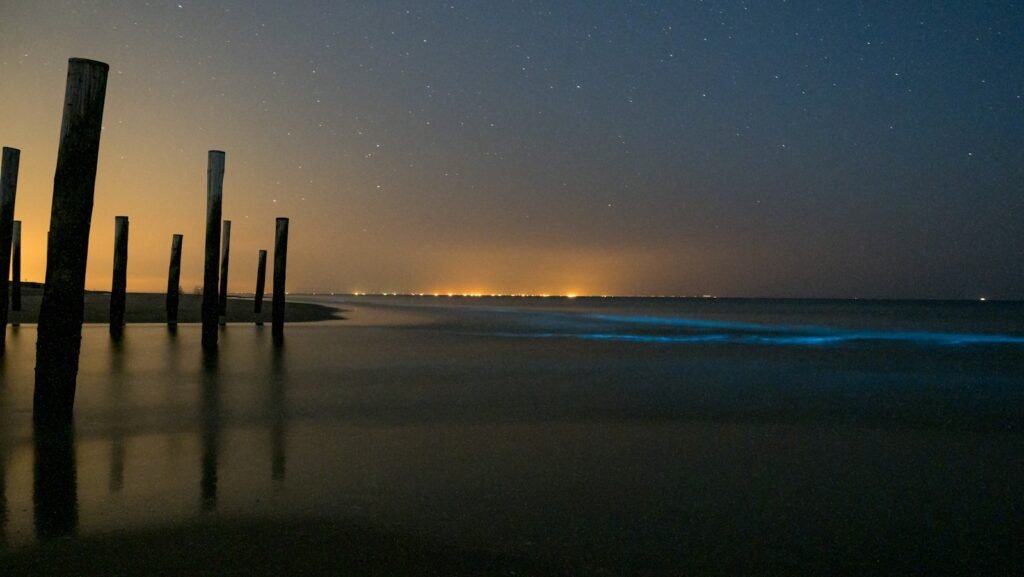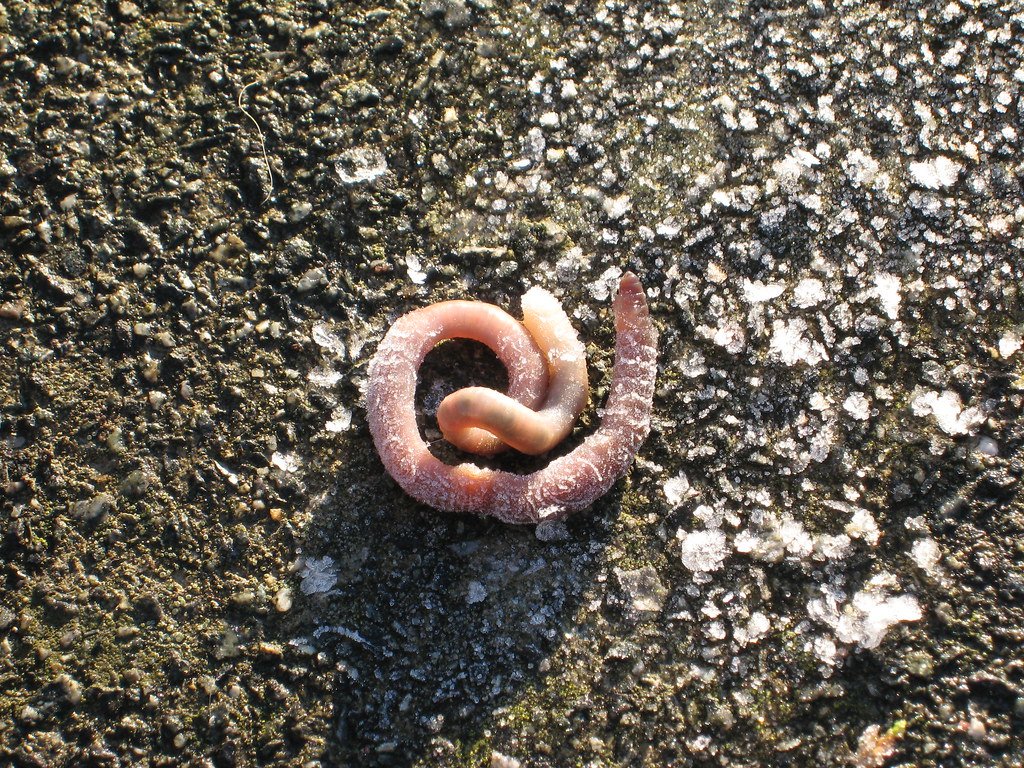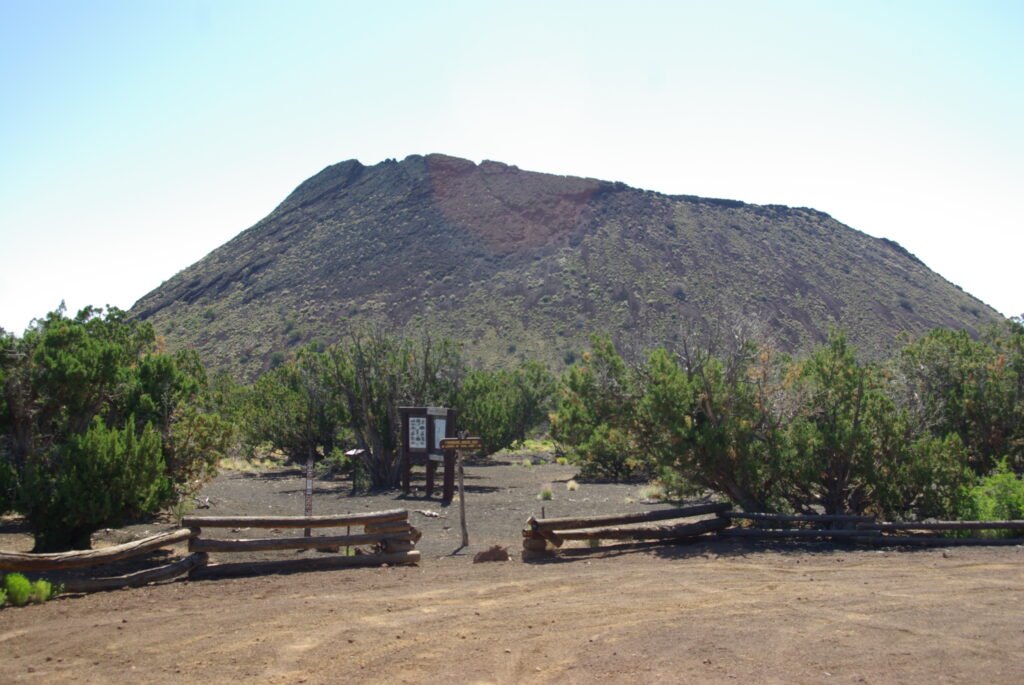On windless nights along the Outer Banks, the Atlantic looks ordinary until the first splash turns everything electric. A new moon slips below the horizon, the sky goes ink‑black, and then the surf starts writing in light – every footstep and wave edge outlined in neon blue. The spectacle feels otherworldly, but it’s the work of living plankton primed to flash at the slightest touch. Scientists are leaning into this brief window of darkness to map where and why the glow appears, and what it signals about a changing coast. The mystery isn’t whether the ocean shines; it’s what these flickers are trying to tell us about the waters that cradle them.
The Hidden Clues

Bioluminescent plankton act like tiny motion sensors, revealing the invisible architecture of the night surf. A single breaking wave sets off a chain of sparks, tracing the curl as it tumbles toward shore. When a fish darts through the shallows, a comet tail of light prints the path it took, a living seismograph for water movement. Even sand stirred by your heel draws a brief glowing underline across the beach. Stand still, and the sea quiets; move again, and the canvas lights back up.
For scientists, these flashes are more than show – they are field notes written in light. The pattern, duration, and brightness hint at which plankton dominate and how many are present. Short, sharp bursts often point to mechanical jostling in choppy water, while long ripples suggest gentler shear. Dense streaks along rip currents can sketch the night’s circulation in real time. Read carefully, and the glow outlines the heartbeat of nearshore waters.
The Science of the Blue Glow

The light comes from a chemical handshake inside single‑celled dinoflagellates: a molecule known as luciferin reacts with the enzyme luciferase, releasing a photon as cellular pH briefly plunges. Shear stress – your paddle stroke, a cresting wave, a shrimp’s flick – triggers that reaction in milliseconds. The flash is brief by design, bright enough to startle or signal but short enough to conserve precious energy. Blue light travels farthest underwater, so evolution tuned the hue to the ocean’s optical sweet spot. What you see as magic is a carefully engineered survival tactic.
Each organism stores its light in microscopic packets often called scintillons, primed like tiny batteries. When disturbed, ion channels open, chemistry runs, and the cell glows, then resets if energy reserves allow. Warmer, nutrient‑rich conditions can fuel denser concentrations, though density alone doesn’t guarantee a great show. The sea still needs darkness, calm surfaces, and a spark to set the scene. That’s where the new moon lends a hand.
New Moon, New Magic

Moonlight can wash color from the night just like city glare erases stars. Around the new moon, the missing skyglow gives the plankton a deeper stage, so even faint flickers stand out. Calm evenings matter too, because rough water can scatter cells and shorten the lifetime of each flash. After a few quiet, warm days, the odds of seeing sustained glow along North Carolina’s barrier islands climb noticeably. That’s when evening walkers begin noticing their footprints ignite.
Tides and wind shape the nightly show more than many people realize. An incoming tide can sweep glowing patches into beach pockets, while a shift in wind can carry them offshore by midnight. River pulses after rain may load nutrients and seed new blooms along sounds and inlets. On some nights the most intense light sits just beyond the breakers, better seen by paddlers than by beachcombers. Patience pays – conditions can flip within an hour.
From Ancient Tools to Modern Science

Mariners have watched glowing wakes for centuries, using them as low‑tech compasses for current and speed. Accounts from sailors crossing the Atlantic describe “sea fire” that came and went with weather and water temperature, a notebook long before lab notebooks. Those observations were messy but surprisingly useful, hinting at the relationship between turbulence and light. The core intuition still holds: disturbance makes living light visible. The ocean writes, and we learn to read.
Today, researchers pair that intuition with sensitive cameras and autonomous instruments. Low‑light sensors quantify brightness down to a whisper, while tiny pumps move water past detectors that count flashing cells. Gliders can cruise at night, mapping where the glow pools like a tide of stars. Laboratory culture work fills in how temperature, salinity, and nutrients set the rules of engagement. The result is a new field guide to coastal nights, grounded in data yet open to wonder.
On the Water: A Night Along the Banks

The first time I slipped a paddle into a glassy tidal creek near Bogue Banks, the blade seemed to paint the water electric. Every stroke curled a ribbon of blue that unspooled behind the kayak, then faded like breath on window glass. A mullet broke the surface and left a dotted line of light, as if someone shook glitter across the creek. I stopped paddling and let the current carry me, just to watch the sparkles fall away. That quiet felt like listening to the ocean think.
Wading into the surf brings a different theater. The foam outlines itself in neon, then shatters into a thousand points that disappear as fast as they appear. If you stand still long enough, the show pauses, waiting. Then a single wave arrives and snaps everything awake again. The beach becomes a dim room where movement is the only switch.
Why It Matters

Bioluminescence isn’t just a spectacle; it’s a signal about the health and dynamics of coastal waters. These plankton sit at the base of the food web, and their nightly flashes mark where energy flows next. When the cast of characters changes – say, a heat wave favors one species over another – the pattern and brightness can shift in step. That makes the glow a real‑time reporter for ocean conditions we often measure too slowly. In a warming world, faster signals matter.
It also matters for people who live and work by the sea. Nighttime glow draws visitors and dollars, but it can also be confused with harmful blooms that discolor water during the day. Luminous events aren’t inherently dangerous, yet they travel with the same currents that can carry irritants or stingers. Clear communication helps communities enjoy the show and avoid needless worry. Science gives us the language to do both.
Global Perspectives

North Carolina’s blue edge joins a worldwide constellation of glowing waters. Surf along parts of California flares with certain seasonal blooms, while Australia’s protected bays flash like shaken snow globes after calm spells. Tropical bioluminescent lagoons can glow so steadily that paddlers leave braided trails behind their boats for minutes. Far offshore, rare “milky seas” driven by bacteria can turn entire swaths of the Indian Ocean ghost‑white for nights on end. The same physics of darkness and disturbance sets the stage everywhere, even if the cast changes.
Those comparisons help researchers test ideas across very different environments. If the same wind pattern brightens waters in Puerto Rico and dims them on the Carolina coast, the difference teaches us something about local plumbing. Cross‑checking observations makes models smarter and forecasts more honest. It also reminds us that light‑making is one of the ocean’s common languages. We’re finally learning to translate instead of just staring.
Tracking the Pulse: What Scientists Measure

To predict where the glow will bloom, teams track temperature, salinity, chlorophyll, and the day’s wind history. Gentle winds and stratified water often set the table, while a burst of mixing can scatter the feast. Instruments count flashes in small water samples to estimate how many light‑makers are present, then compare that with current speed and wave energy. The shape of each burst – fast or slow, bright or dim – adds clues about which species dominate. Even shoreline light pollution gets logged, because glare can drown the glow.
Community observations add an invaluable layer. Beachgoers note the time, location, tide, and sky conditions when they see blue surf, then share photos with exposure settings. Paddlers report whether the strongest glow sat in creeks, behind sandbars, or just outside the break. Those notes help fill gaps between instruments and satellite passes. In short, the coastline becomes a living laboratory after dark.
The Future Landscape

Forecasting tools are moving from folklore to phone screen. Picture models that blend moon phase, recent wind, water temperature, and plankton data to give a glow‑probability map for specific beaches. Autonomous surface craft could scout at dusk, relaying brightness in near real time. Low‑light cameras keep getting better, meaning the threshold for detection keeps dropping. Even a modest improvement can turn a maybe into a yes for a night’s fieldwork.
Challenges loom. Shoreline construction brightens the horizon and steals contrast from the show. Warming and altered rainfall can rearrange plankton communities, shifting the calendar and geography of peak glow. Stronger storms may both fertilize and disrupt, making year‑to‑year predictions trickier. Still, the path forward is clear: combine better sensors with smarter models, and share results widely so coastal communities can plan.
How to See It Right

Plan for the darkest nights – new moon or close to it – and aim for beaches with minimal streetlights. Let your eyes adjust for ten minutes before splashing around, and switch off bright flashlights or cover them with red film. Walk gently at first to see how the water responds, then try a slow foot drag in the swash zone. If you paddle, dip the blade softly and watch the ribbon unfurl behind you. Give the scene time; the best glow often comes in pulses.
Be kind to the organisms that make the magic. Skip lotions or sprays that wash off easily before you wade, and rinse gear away from creeks. Avoid scooping glowing water into bottles, which strains delicate cells and removes them from their habitat. Keep wildlife first – no chasing fish or stirring flats where shorebirds feed. Leave the beach a little darker and cleaner than you found it.
Closing Thoughts

On a moonless night, the ocean stops pretending it’s ordinary and tells a bright, living story. Each flash is a syllable, each wave a sentence, and for a few hours the coastline reads like a novel you can’t put down. The science doesn’t dim that wonder; it gives the plot depth and the characters names, even if we still argue about a few twists. North Carolina’s glow is both signal and spectacle, a rare case where public joy and research needs align. The next clear new‑moon night, step outside and let the water do the talking – then ask yourself what it’s saying.
Will you be there to see the ocean write in blue?

Suhail Ahmed is a passionate digital professional and nature enthusiast with over 8 years of experience in content strategy, SEO, web development, and digital operations. Alongside his freelance journey, Suhail actively contributes to nature and wildlife platforms like Discover Wildlife, where he channels his curiosity for the planet into engaging, educational storytelling.
With a strong background in managing digital ecosystems — from ecommerce stores and WordPress websites to social media and automation — Suhail merges technical precision with creative insight. His content reflects a rare balance: SEO-friendly yet deeply human, data-informed yet emotionally resonant.
Driven by a love for discovery and storytelling, Suhail believes in using digital platforms to amplify causes that matter — especially those protecting Earth’s biodiversity and inspiring sustainable living. Whether he’s managing online projects or crafting wildlife content, his goal remains the same: to inform, inspire, and leave a positive digital footprint.




